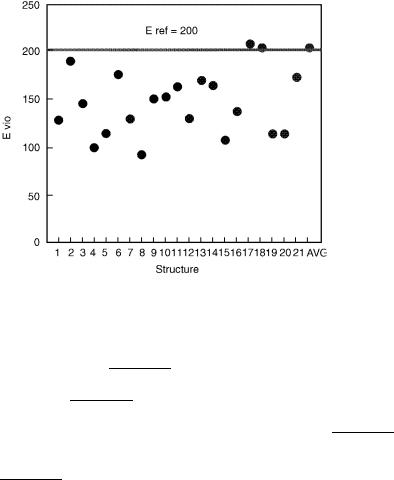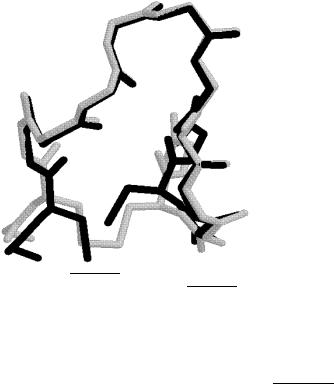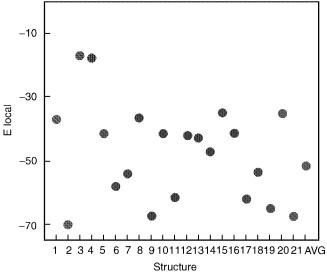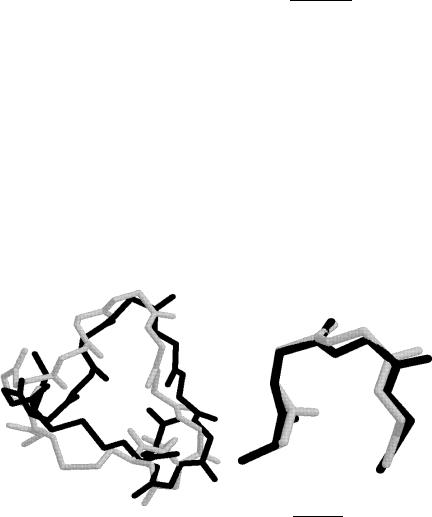
Friesner R.A. (ed.) - Advances in chemical physics, computational methods for protein folding (2002)(en)
.pdf346 |
john l. klepeis et al. |
long-range information was used in developing the constraints, because intra-residue restraints are less likely to affect the overall fold. Although the formulation can handle multiple constraints, distance restraints were included as one constraint (NCON ¼ 1) for the computational studies.
4.Choose the value of Elref to be used in the constraint equations. This can be determined by simply performing several local constrained optimizations
or possibly a short global optimization run with simplified energy models. In this work, information based on X-PLOR [96] results was used to define the Eref parameter (see below).
5.Identify initial a values for both the objective and constraint functions.
6.Set initial best upper bound to an arbitrarily large value.
The computation phase of the algorithm involves an iterative approach, which depends on the refinement of the original domain by partitioning along the global variables. In each subdomain, upper and lower bounding problems are solved locally and used to develop the sequence of converging upper and lower bounds. The basic steps are as follows:
1.The original domain is partitioned along one of the global variables.
2.Lower bounding functions for both the objective and constraints are constructed in both subdomains. A constrained local minimization is performed using the following procedure:
a.100 random points are generated and used for evaluation of the lower bounding objective function and constraints. The point with the minimum objective function value is used as a starting point for local minimization using NPSOL.
b.If the minimum value found is greater than the current best upper bound, the subdomain can be fathomed (global minimum is outside region); otherwise the solution is stored.
3.The upper bounding problems (original constrained formulation) are then solved in both subdomains according to the following procedure:
a.100 random points are generated and used for evaluation of the objective function and constraints. The point with the minimum objective function value and feasible constraints is used as a starting point for local minimization using NPSOL. If a feasible starting point is not found, local minimization is not performed.
b.All feasible solutions are stored.
4.The current best upper bound is updated to be the minimum of those thus far stored.
5.The subdomain with the current minimum value of Lforcefield is selected and partitioned along one of the global variables.

deterministic global optimization and ab initio approaches 347
6.If the best upper and lower bounds are within a defined tolerance, the program will terminate; otherwise it will return to Step 2.
To enhance the search for low-energy feasible points, the basic procedure described in Step 3a is modified to include TAD. The following protocol is used:
1.Set counter, c ¼ 1. Perform TAD (1000 high-temperature steps followed by 3000 annealing steps) using ES as the target function. The torsion angle bounds of the current subdomain determine the dihedral angle restraint functions. In addition to the NOE-derived distance restraints, sterically based distance restraints are added to prevent van der Waals overlaps.
a. If the Eldistance < Elref 8 l ¼ 1; . . . ; NCON, go to Step 2. Else go to Step 1b.
b.Increment counter, c ¼ c þ 1. If c < 5, reduce weight of sterically based distance restraints, perform new TAD and go to Step 1a. Else go to Step 2.
2.Set counter, c ¼ 1. Perform local minimization using NPSOL with dihedral angle box constraints to implicitly enforce bounds. The objective function is a weighted combination of forcefield energy and distance restraint terms:
E ¼ EECEPP/3 þ XWlEldistance |
ð86Þ |
l |
|
where the weights, Wl, are based on the violation of the distance constraints:
|
sl |
|
|
Wl ¼ |
1 þ |
Edistance |
ð87Þ |
Elref |
|||
a. If Eldistance < Elref 8 l ¼ 1; . . . ; NCON, go to Step 3. Else go to Step 2b.
b.Increment counter, c ¼ c þ 1. If c < 5, increase weight of distance restraint terms, perform TAD (100 high-temperature steps followed by 300 annealing Steps) and go to Step 2a. Else go to Step 3.
3.Solve the constrained minimization problem using NPSOL.
5.Computational Study
The global optimization algorithm was tested on Compstatin, a synthetic 13residue (ICVVQD WGHHRCT) cyclic peptide (disulfide bridge between the Cys2 and Cys12 residues) that binds to C3 (third component of complement) and inhibits complement activation [102]. Two-dimensional NMR techniques [103] yield a total of 30 backbone sequential (including Hb - backbone), 23 mediumand long-range (including disulfide), and 82 intra-residue NOE restraints. In

348 |
john l. klepeis et al. |
addition, 7 f angle and 2 w1 angle dihedral restraints are available. In previous work [103], traditional distance geometry-simulated annealing protocol was utilized to minimize the associated target function in the Cartesian coordinate space using the program X-PLOR [96]. NOE distance and dihedral angle restraints were modeled using a quadratic square well potential, while van der Waals overlaps were prevented through the use of a simple quartic potential function.
The NMR refinement protocols resulted in a family of 21 structures with similar geometries for the Gln5–Gly8 region. A representative structure was obtained by averaging the coordinates of the individually refined structures and then subjecting this structure to further refinement to release geometric strain produced by the averaging process. The formation of a type I b-turn was identified as a common characteristic for these structures.
The consistency of the ensemble of Compstatin solution structures was determined by evaluating distance restraints for each of the original 21 structures (accession number 1a1p at the RCSB, http://www.rcsb.org), as well as for the average Compstatin conformation. In considering distance restraints, only backbone sequential and medium/long-range NOEs were considered. That is, the 82 intra-residue restraints were neglected because they are less likely to effect the overall fold of the Compstatin peptide. This results in a total of 52 restraints, with an additional restraint on the distance between the sulfur atoms forming the disulfide bridge. In order to quantify these results, the violation energy, EVIO, which can be calculated by summing Eqs. (59) and (60), was calculated for each of the original PDB structures. In these calculations, the value of the weighting factor (Aj) was assumed to be constant and set equal to
˚ 2
50 kcal/mol/A .
The results of the analysis, shown graphically in Fig. 25 indicate that the average structure (Compstatin) possesses the third largest violation energy, whereas the smallest value is provided by structure 8 (hCompstatini8). These quantities provide a range of comparison for violation energies and were used to set the constraint parameter, Eref , to 200 kcal/mol. This value is chosen so that the sum of the violation energies will necessarily result in an improvement over the violation energy for the average Compstatin structure.
To measure the performance of the proposed global optimization approach, the ensemble and average Compstatin structures (hCompstatini and Compstatin) were then used as starting points for local minimization. Because these calculations are performed in the torsion angle space, which requires fixing bond lengths and bond angles to equilibrium values, the corresponding Compstatin PDB structures could only be used to derive torsion angle values. These dihedral angles were then used as input to directly evaluate the corresponding force field energy. Differences in bond lengths and bond angles propagate through the generation of the corresponding ECEPP/3 structure,

deterministic global optimization and ab initio approaches 349
Figure 25. Violation energy, EVIO, for original Compstatin PDB structures.
which produces an inherent RMSD between the PDB structure and the ECEPP/ 3-generated structure. For example, when using the set of dihedral angles calculated from the Compstatin PDB, the ECEPP/3 structure possesses a 0.581
˚
A all atom RMSD (all heavy atoms in backbone and side chains) with respect to
the original Compstatin structure, with a corresponding ECEPP/3 energy of 519.2 kcal/mol. In addition, due to the differences in bond lengths and angles,
the total distance violation for the ECEPP/3 structure (CompstatinECEPP)
˚
increases from 6.9 to 8.7 A, which results in a subsequent increase in violation energy to 315 kcal/mol. The superposition of the original and ECEPP/3 Compstatin conformations is shown in Fig. 26.
Due to the relatively large distance violations and energies obtained after transformation of PDB to PACK (ECEPP/3) structures, the 22 structures were then subjected to local minimization. The problem formulation for local minimization uses the set of 53 restraints for the constraint function, a constant
˚ |
ref |
, equal to |
50 kcal/mol/A weighting factor (Aj), and a constraint parameter, E |
|
200 kcal/mol. In all cases, the corresponding violation energy reached the upper bound value of 200 kcal/mol. The corresponding total distance violations in-
˚ |
distance violation |
|
creased, with an average value of 6.766 A. The smallest |
||
˚ |
Local |
|
(5.873 A) was reported for structure number 10 (hCompstatini10 |
), whereas the |
|
corresponding energy for this structure ( 41.685 kcal/mol) was only slightly above the average energy of 47.75 kcal/mol. The lowest energy structures

350 |
john l. klepeis et al. |
Figure 26. Superposition of (CompstatinOrig) structure (in light gray) and corresponding
ECEPP/3 structure (in black) using calculated dihedral angles (CompstatinECEPP).
|
Local |
68.704 |
kcal/mol for |
h |
Compstatin |
Local, |
||
( 71.613 for hCompstatini2 |
, Local |
|
|
|
i21 |
|||
67.653 kcal/mol for |
hCompstatini9 |
|
) provided above average values for |
|||||
total distance violation |
˚ |
|
˚ |
˚ |
|
|
|
|
(6.963 A, 6.832 A, 7.120 A, respectively). In addition, |
||||||||
the conformation obtained from the average Compstatin structure (Compstatin) exhibited near average values for energy ( 52.283 kcal/mol) and total distance
˚
violations (6.392 A). The range of ECEPP/3 energies after local minimization are shown in Fig. 27.
The structural characteristics of these locally minimized structures were quantified using RMSD (root-mean-squared deviation) calculations. For the original PDB structures, comparison with the average Compstatin structure
˚
provided RMSD values between 1 and 2 A for only backbone atoms. As expected, these structures possess common structural features. However, when comparing original PDB structures and their locally minimized counter-
˚
parts, most RMSD values are larger than 2 A, indicating that significant conformational changes occur during local minimization. This is due to both the reduced set of NOE restraints in the constraint function and the role of the detailed energy force field. In contrast, the RMSD values for the b-turn region remain consistently low when comparing the original PDB structures to their locally minimized counterparts. These results indicate that the b-turn is a conserved structural feature, even with the addition of the detailed energy model.

deterministic global optimization and ab initio approaches 351
Figure 27. Locally minimized energy, EECEPP=3, for Compstatin structures.
The constrained global optimization approach was first applied to Compstatin structure prediction without the use of TAD. A subset of 26 (all f and c) torsion angles, from a total of 73, were treated globally, whereas the remaining ones were allowed to vary locally. As was the case for local minimization, the same set of restraints were used to formulate the nonlinear constraint, with
˚
a constant 50 kcal/mol/A weighting factor and a constraint parameter equal to 200 kcal/mol. The lowest-energy structure satisfying the constraint functions provided an ECEPP/3 energy of 85.71 kcal/mol, an energy value more than 15 kcal/mol lower than those values provided by local minimization. The global minimization required approximately 40 CPU hours on a HP C160. The total
˚
distance violation equaled 6.690 A, which is near the average distance violation for the local minimum structures.
RMSD calculations were performed to again quantify the structural differences between the global minimum energy structure and the other Compstatin structures. RMSD values between the full backbone and the b-turn segments of the 22 locally minimized PDB structures and the global minimum energy
structure are plotted in Figs. 28 and 29, respectively. When comparing full backbone RMSD vcalues, the hCompstatiniLocal9 , hCompstatiniLocal21 , hCompstatiniLocal19 and hCompstatiniLocal17 provide the best agreement with the
global minimum energy structure. These structures also correspond to four of the lowest energy local minima, indicating that some of the lowest energy



354 |
john l. klepeis et al. |
|
|
|
|
TABLE XXI |
|
Local Minimization Results for the Best DYANA (TAD)-Generated Conformationsa |
|||
|
|
|
|
Local Minimum |
˚ |
EVIO (kcal/mol) |
EECEPP/3 (kcal/mol) |
DVIO (A) |
|||
Compstatin1DYANA |
6.234 |
200.0 |
11.945 |
CompstatinDYANA |
6.538 |
200.0 |
6.782 |
2 |
|
|
10.208 |
Compstatin3DYANA |
6.163 |
200.0 |
|
Compstatin4DYANA |
5.476 |
200.0 |
14.516 |
CompstatinDYANA |
6.927 |
200.0 |
5.006 |
5 |
|
|
|
aHere DVIO refers to the total distance violation, EVIO is the corresponding violation, and energy and EECEPP/3 is the force field energy at the local minima.
exhibiting the best target values were then used as starting points for a second set of runs. Finally, a set of five conformations (with the smallest violations) were used for further analysis. Because each method (DYANA vs. ECEPP/3) employed different structural definitions, based on fixed bond lengths and bond angles, a direct comparison was not sufficient. Instead, the DYANAgenerated structures were used as starting points for local minimizations using the local constrained formulation. In all cases, the violations reached the upper bound of 200 kcal/mol for Eref. The corresponding violation values, including
final local minimum energy values (EECEPP=3), are given in Table XXI.
The results given in Table XXI indicate that although the DYANA conformers satisfy the corresponding constraint, their energy values are significantly higher than that of the global minimum energy structure (more than 70 kcal/mol). This can be anticipated because the goal of the DYANA algorithm is to minimize distance restraint violations via penalty term optimization, while neglecting any detailed force field terms. In fact, an analysis of the structural characteristics indicate that the type I b-turn does not appear along the Gln5– Gly8 backbone in these structures. This is verified by the data in Table XXII, which gives the f and c dihedral angle values for the central b-turn residues.
TABLE XXII
f and c Values for Central Residues (Asp6 and Trp7) for Anticipated b-Turn Regiona
Local minimum |
f2 ( ) |
c2 ( ) |
f3 ( ) |
c3 ( ) |
Compstatin1DYANA |
166.9 |
66.07 |
80.00 |
40.40 |
Compstatin2DYANA |
165.9 |
65.55 |
81.02 |
33.99 |
Compstatin3DYANA |
180.0 |
60.94 |
81.76 |
42.43 |
Compstatin4DYANA |
168.8 |
50.32 |
80.00 |
42.22 |
Compstatin5DYANA |
165.4 |
72.75 |
97.79 |
39.86 |
aThe subscripts refer to the second and third residues in the Gln5–Gly8 sequence.

deterministic global optimization and ab initio approaches 355
TABLE XXIII
Local Minimization Results for the Best DYANA (TAD)-Generated
Conformations Using All Restraints.a
Local minimum |
˚ |
EVIO (kcal/mol) |
EECEPP/3 (kcal/mol) |
DVIO (A) |
|||
CompstatinDYANA |
6.222 |
200.0 |
24.714 |
1c |
|
|
31.216 |
Compstatin2DYANAc |
5.643 |
200.0 |
|
Compstatin3DYANAc |
6.527 |
200.0 |
17.569 |
Compstatin4DYANAc |
7.135 |
200.0 |
27.110 |
Compstatin5DYANAc |
5.926 |
200.0 |
14.656 |
aHere DVIO refers to the total distance violation, EVIO is the corresponding violation, and energy and EECEPP/3 is the forece field energy at the local minima.
The problem is evidenced by the Asp6 residue, which has f–c values in a forbidden region of the Ramachandran plot. It appears that this may be related to clustering of the side chains in the DYANA-predicted structures.
In order to further examine this deviation from the previous results (which define a type I b-turn), the DYANA protocol was also tested on the full set of restraints, including intra-residue distances. The five DYANA-predicted structures exhibiting the lowest target function values were then subjected to local minimization using the constrained formulation. As before, only the 53 mediumand long-range distance restraints were included during the local minimizations. As the results in Table XXIII show, the average energy has decreased for this set of conformers. However, the structural analysis of the Gln5–Gly8 region, given in Table XXIV still indicates that a type I b-turn is not preferred.
An additional comparison between the structural characteristics of these (DYANA) local minima and the global minimum was also performed using RMSD calculations, as given in Tables XXV and XXVI. These values are consistently larger than those between the average (CompstatinLocal) and local
TABLE XXIV
f and c Values for Central Residues (Asp6 and Trp7) for Anticipated b-Turn Regiona
Local Minimum |
f2 ( ) |
c2 ( ) |
f3 ( ) |
c3 ( ) |
Compstatin1DYANAc |
180.0 |
58.61 |
80.00 |
47.72 |
Compstatin2DYANAc |
177.5 |
63.77 |
82.74 |
33.53 |
Compstatin3DYANAc |
180.0 |
63.98 |
82.18 |
23.32 |
Compstatin4DYANAc |
163.0 |
58.56 |
109.2 |
4.53 |
Compstatin5DYANAc |
180.0 |
70.46 |
92.40 |
41.22 |
aThe subscripts refer to the second and third residues in the Gln5– Gly8 sequence.
